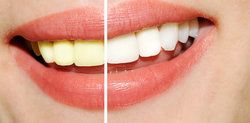How to Treat Different Types of Tooth Discoloration
 The appearance of the smile can have a significant effect on one’s self-esteem. Dr. Andrew G. Mortensen is a cosmetic dentist focused on creating beautiful and healthy smiles that promote confidence. One of the simplest ways to improve the aesthetics of the smile is to enhance the color of the teeth by treating discoloration and stains. However, it is important for patients to understand that there are different types of tooth discoloration. We offer our Fountain Valley patients tooth discoloration treatment that is personally recommended based on the types of stains and discoloration that are present.
The appearance of the smile can have a significant effect on one’s self-esteem. Dr. Andrew G. Mortensen is a cosmetic dentist focused on creating beautiful and healthy smiles that promote confidence. One of the simplest ways to improve the aesthetics of the smile is to enhance the color of the teeth by treating discoloration and stains. However, it is important for patients to understand that there are different types of tooth discoloration. We offer our Fountain Valley patients tooth discoloration treatment that is personally recommended based on the types of stains and discoloration that are present.
Surface Discoloration
As the name would suggest, surface discoloration and stains, also known as extrinsic stains, are those that are present on the surface, or outer layer of tooth enamel. These stains or discoloration do not affect the deeper layers of the tooth. Surface discoloration is often caused by foods and beverages such as coffee, tea, wine, and cola, or by oral habits such as smoking or chewing tobacco.
Because this discoloration is only present on the surface of the teeth, it is considered superficial and can often be easily treated with teeth whitening. Teeth whitening can erase stains and brighten the teeth by up to eight shades in as little as an hour, drastically improving the appearance of the smile. In order to meet the unique needs of our patients, Dr. Mortensen offers both in-office and at-home teeth whitening options.
Inner Discoloration
Inner, or intrinsic, discoloration and stains are those that penetrate to the inner layers of the tooth, or the dentin. Stains and discoloration that affect the dentin are usually caused by prolonged exposure to fluoride or certain medications. Intrinsic discoloration may also be a problem in patients who have suffered from acid erosion. This can cause the outer layer of tooth enamel to wear down, revealing more of the inner dentin, which may appear gray and dull rather than white.
Teeth with inner discoloration cannot easily be treated with teeth whitening. The best method for treating teeth with inner discoloration or stains is to conceal the stains with dental bonding or porcelain veneers. Both of these treatments cover up stains and discoloration to reveal clean, white teeth. Which treatment is most appropriate will depend largely on the extent of the discoloration and how many teeth are affected.
Age Related Discoloration
As with most parts of the body, over time the teeth will begin to wear down and show signs of aging. Aged teeth may suffer from outer discoloration, inner discoloration, or a combination of both. Based on the type and amount of discoloration present, Dr. Mortensen may recommend teeth whitening, dental bonding, porcelain veneers, or a combination of treatments. Whatever the treatment may be, Dr. Mortensen can revitalize the appearance of the smile by brightening and whitening the teeth.
Schedule an Appointment
Fashions and styles may change over time, but a bright, white smile will always be considered beautiful. If you are interested in improving the color of your teeth or have other cosmetic flaws that you’d like to have addressed, schedule an appointment with Dr. Andrew G. Mortensen at your earliest convenience. A beautiful smile may be just an appointment away.



